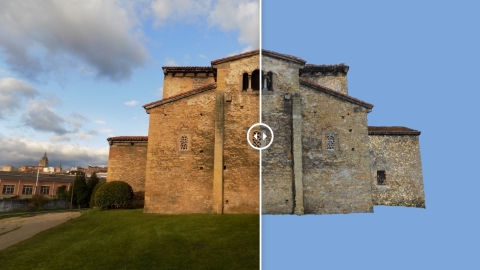Reconstruction of a pre-romanesque church using SfM
During the academic year 2015/16 a group of students and myself have been working on the reconstruction of a pre-romanesque church using Structured from Motion methods. The original idea was due to Ana Arobes-Diaz, and the team of students that was working in the project comprised Nerea la Torre-Fernandez, Andrea Rodriguez-Mayo and Mario Perez-Rodriguez.
In this webpage you can check the results of such project and download some of the products such as pointclouds and meshes at different resolutions.
And yes, we could have used (and indeed we did try) 123 Catch or Photosynth but they are simply unable to properly handle thousands of pictures and/or produce the result we aimed to.
Orthophotos
Click on the photos to explore zoomable large versions.




Perspective views
Click on the photos to explore zoomable large versions.


Video
Point cloud
You can browse the actual 81 million points cloud by clicking on the picture

Meshes
You can play with meshes at different resolutions in Sketchfab and TinkerCAD (click on the pictures).


The TinkerCAD version is printable and, as you can see, there have been many flawed versions before this one:


Real vs Virtual








Pitfalls and caveats
- Please note that there is no geographical or topographical information attached to the data.
- Although pictures were taken with some caution they are not color balanced and some of them unfortunately were taken with hard shadows or direct sunlight.
- Not all of the building was photographed at the same distance and, thus, there are noticeable differences of point density and, thus, resolution.
- Roofs and the back of the bell-gable are not accurate and they were actually modelled from other parts and not reconstructed.
- Remember that it was a teacher-student work and we were learning on the go. Still, it is a full reconstruction of a whole building which is 30 meters long and 26 meters wide...
Downloads
- 81 million points cloud. Useful to create your own meshes. (PLY format, 2.1 GB).
- High resolution mesh (38M faces and 18M points, PLY format, 904 MB).
- Medium resolution mesh (8M faces and 4M points, PLY format, 218MB).
- Low resolution mesh (2M faces and 900K points, PLY format, 46 MB).
- Printable version (STL format, 79 MB).
Acknowledgements
We are in debt with Carlota Abello from Dogram who delivered a fantastic lecture on SfM applied to cultural heritage and provided very valuable advice to our team.
As said, the original idea of reconstructing a pre-romanesque building was due to Ana Arobes who worked on her own to reconstruct San Miguel de Lillo as it was originally built.



Tools
We have used the following software and tools (most of it is open source, free, online or there are educational licenses):- VisualSfM (to create the sparse point clouds and the input for pmvs2 in desktop computers).
- pmvs2 (to create the dense clouds in a server).
- CloudCompare (to visualize, clean and create draft meshes in desktop computers).
- Meshlabserver (to create high definition colored meshes).
- Sketchfab (to provide online interactive visualization of meshes).
- TinkerCAD (to provide an online way to work with the printable mesh).
- IIPImage and IIPMooViewer (to provide zoomable large scale pictures in the browser).
- Potree (to allow an interactive visualization of point clouds in the browser).
- The TwentyTwenty jQuery plugin for the real vs virtual comparisons.
- Cura (to create the gcode for our printer).
- 3DS Max (to create the animation).
- Windows Movie Maker (to edit the video).
- YouTube (to host the videos).
Addendum, February 2019
Some experiments have been done processing part of the pictures with Meshroom. Results are really good and the software is much more confortable that the combination of VisualSfM+pmvs2+CloudCompare+Meshlabserver. The only caveat, you need a relatively good GPU.

